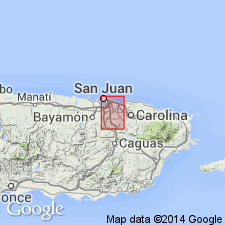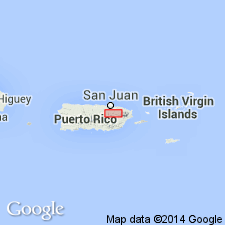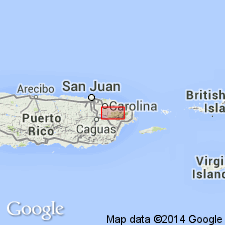
- Usage in publication:
-
- Guaynabo formation*
- Modifications:
-
- Revised
- AAPG geologic province:
-
- Caribbean region
Summary:
The Guaynabo formation is here revised and adopted. Overlies the Hato Puerco tuff but underlies the Tortugas andesite rather than the La Muda limestone (here redefined as the La Muda limestone member of the Frailes formation). The beds cropping out in the vicinity of Guaynabo do not include sedimentary rocks having the stratigraphic position given by Meyerhoff and Smith; thus the limits of the Guaynabo are drawn to include only the section of noncarbonate sediments overlying the Hato Puerco and underlying the Tortugas or, where it is missing, the Frailes formation. Consists of medium- to thick-bedded, gritty graywacke, shale, and conglomerate, and in places, beds of fine ash or siltstone. Thickness ranges up to 4,500 ft. Age is Late Cretaceous(?) based on fossils in the conformably overlying Frailes.
Source: GNU records (USGS DDS-6; Reston GNULEX).

- Usage in publication:
-
- Guaynabo Formation*
- Modifications:
-
- Revised
- AAPG geologic province:
-
- Caribbean region
Summary:
The Guaynabo Formation, named by Meyerhoff and Smith (1931) and revised by Kaye (1959), is here revised to include coarse grained lapilli tuff mapped by Kaye as Frailes Formation. Includes the here named Martin Gonzalez Lava Member midway between the base of the formation and the Leprocomio Siltstone Member at the top (Kaye's Leprocomio Limestone Member at the top of his Frailes, here revised). Consists of greenish-gray pillowed lava at the base, similar to lava in the Santa Olaya, interbedded siltstone and volcanic wacke and conglomerate beds. Interlayered with tongues of Tortugas Andesite in the western part of the Aguas Buenas quadrangle. Thickness at type section is 1,200 to 1,600 m. Age is Late Cretaceous (late Cenomanian to late Campanian).
Source: GNU records (USGS DDS-6; Reston GNULEX).

- Usage in publication:
-
- Guaynabo Formation
- Modifications:
-
- Not used
- AAPG geologic province:
-
- Caribbean region
Summary:
The Guaynabo Formation as used by Pease (1968) in the Aguas Buenas quadrangle to include both the Guaynabo and Frailes of Kaye (1959), is here revised in the Gurabo quadrangle. The name is not used and the strata are divided into several formations. The name Frailes is retained to describe beds continuous with beds at the type locality. Martin Gonzalez Lava Member of the Guaynabo is here raised to Martin Gonzalez Lava at formation rank. The Leprocomio Siltstone Member of the Guaynabo is here revised to Leprocomio Mudstone Member of the Frailes Formation.
Source: GNU records (USGS DDS-6; Reston GNULEX).

- Usage in publication:
-
- Guaynabo Formation*
- Modifications:
-
- Overview
- AAPG geologic province:
-
- Caribbean region
Summary:
The Guaynabo Formation occurs in eastern Puerto Rico and consists of interbedded volcanic sandstone and tuffaceous siltstone, and volcanic conglomerate and pillowed andesitic lava flows at the base and middle of unit. Maximum thickness is 1600 meters. The Guaynabo is of Late Cretaceous age.
Source: GNU records (USGS DDS-6; Reston GNULEX).
For more information, please contact Nancy Stamm, Geologic Names Committee Secretary.
Asterisk (*) indicates published by U.S. Geological Survey authors.
"No current usage" (†) implies that a name has been abandoned or has fallen into disuse. Former usage and, if known, replacement name given in parentheses ( ).
Slash (/) indicates name conflicts with nomenclatural guidelines (CSN, 1933; ACSN, 1961, 1970; NACSN, 1983, 2005, 2021). May be explained within brackets ([ ]).

